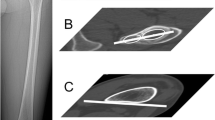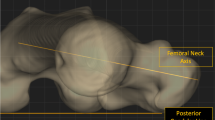Abstract
In this study, the association between increased femoral anteversion and external torsion of the leg was investigated by computed tomography in adults. In a control group of 15 women, the anteversion angle of the femoral neck measured 11°±9° and 12°±9° for the right and left sides, respectively. The external torsion of the leg was 40°±8° and 39°±10°, respectively. The patient group consisted of 16 women who were evaluated for clinical symptoms related to increased femoral anteversion. In this group, the femoral anteversion was 31°±7° and 33°±7° for the right and left sides, respectively, and the external torsion of the leg was 35°±10° and 33°±12°, respectively. There were no correlations between the degree of femoral anteversion and the degree of external torsion of the leg. This study indicates that in cases of increased femoral anteversion, compensatory external torsion of the leg does not develop regularly during growth.
Similar content being viewed by others
References
Alvik I (1960) Increased anteversion of the femoral neck as a sole sign of dysplasia coxae. Acta Orthop Scand 29:301
Fabry F, McEwen GD, Shands AR (1973) Torsion of the femur. A follow-up study in normal and abnormal conditions. J Bone Joint Surg [Am] 55:1726
Hernandez RJ, Poznanski AK (1985) CT evaluation of pediatric hip disorders. Orthop Clin North Am 16:513
Hutter CG, Scott W (1949) Tibial torsion. J Bone Joint Surg [Am] 31:51
Jakob RP, Haertel M, Stüssi E (1980) Tibial torsion calculated by computerised tomography and compared to other methods of measurements. J Bone Joint Surg [Br] 62:238
Jend HH, Heller M, Dallek M, Schoettle H (1981) Measurement of tibial torsion by computed tomography. Acta Radiol [Diagn] (Stockh) 25:325
Kobyliansky E, Weissman SL, Nathan H (1979) Femoral and tibial torsion: a correlation study in dry bones. Int Orthop 3:145
LeDamany P (1909) La torsion du tibia, normale, pathologique, experimentale. J Anat Physiol 45:5983
Reikerås O, Bjerkreim I (1982) Anteversion of the femoral neck. Acta Orthop Scand 53:839
Reikerås O, Høiseth A (1989) Torsion of the leg determined by computed tomography. Acta Orthop Scand 60:330
Reikerås O, Bjerkreim I, Kolbeinstvedt A (1983) Anteversion of the acetabulum and femoral neck in normals and in patients with osteoarthritis of the hip. Acta Orthop Scand 54:18
Scholder P (1968) L'antétorsion physiologique du col femorale et la coxa antétorsa en marge des dysplasies congenitales de la hanche. Ther Umsch 25:545
Staheli LT, Engel GM (1972) Tibial torsion. Clin Orthop 86:183
Svenningsen S, Apalset K, Terjesen T, Anda S (1989) Regression of femoral anteversion. A prospective study of intoeing children. Acta Orthop Scand 60:170
Yagi T, Sasaki T (1986) Tibial torsion in patients with medial type osteoarthritic knee. Clin Orthop 213:177
Author information
Authors and Affiliations
Rights and permissions
About this article
Cite this article
Reikerås, O. Is there a relationship between femoral anteversion and leg torsion?. Skeletal Radiol. 20, 409–411 (1991). https://doi.org/10.1007/BF00191081
Issue Date:
DOI: https://doi.org/10.1007/BF00191081




